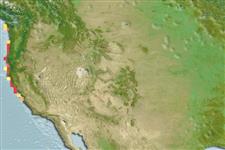>
Perciformes/Scorpaenoidei (Scorpionfishes) >
Sebastidae (Rockfishes, rockcods and thornyheads) > Sebastinae
Etymology: Sebastes: Greek, sebastes = august, venerable (Ref. 45335); diaconus: Name from Latinized ancient Greek διa;κονος, th, meaning an acolyte or assistant to a priest (complements S. mystinus which was intended to mean 'priest'; highlights the similarity between the 2 species and the previous lack of differentiation..
Environment: milieu / climate zone / depth range / distribution range
Écologie
marin récifal; profondeur 8 - 50 m (Ref. 103574). Subtropical; 48°N - 35°N (Ref. 103574)
Distribution
Pays | Zones FAO | Écosystèmes | Occurrences | Point map | Introductions | Faunafri
Eastern Pacific: from Vancouver Island in British Columbia to a southernmost record in Morro Bay, California
Length at first maturity / Taille / Poids / Âge
Maturity: Lm 28.0 range ? - ? cm
Max length : 33.0 cm SL mâle / non sexé; (Ref. 103574); âge max. reporté: 32 années (Ref. 126416)
Description synthétique
Clés d'identification | Morphologie | Morphométrie
Épines dorsales (Total) : 12 - 13; Rayons mous dorsaux (Total) : 14 - 17; Épines anales: 3; Rayons mous anaux: 8 - 9. This species is distinguished from its congeners, except S. ciliatus, S. melanops, S. mystinus, by having a dark gray, blue, brown, or black body coloration; scales on mandible; weak or no head spination; differs from S. ciliatus and S. melanops by the maxilla not extending beyond the posterior margin of the pupil when the mouth is closed; from S. ciliatusby having 4 bars of dark pigmentation that extend across the head and nape (vs. almost uniformly dark head coloration with 2 faint bars below the orbit) and with 26-27 vertebrae (vs. 28-29); differs from S. melanops by having a uniform, light blue-gray, speckled pattern on the trunk (vs. darker black-gray coloration with irregular areas of dark pigmentation ranging from speckling to blotches) and by having dark dorsal-fin membranes without dark spots; differs from S. mystinus by the brownish-blue to blue-gray trunk with distinct lighter blue-gray speckles (vs. steel-blue to greenish-blue body coloration and large, dark blotches which are also apparent in preserved specimens) - this character is indistinct in many individuals under 10.0 cm SL; differs from S. mystinus with individuals over 15.0 cm SL, by having the ventral margin of head and ventrum generally flat (vs. rounded) and by the allometric development of the symphyseal knob, length of dentary symphysis 4.0-7.0% HL (vs. 2.6-5.7% HL) - although these ratios overlap, the symphyseal knob length differs diagnostically among specimens of equal size over 15.0 cm SL (Ref. 103574).
Life cycle and mating behavior
Maturities | Reproduction | Spawnings | Egg(s) | Fecundities | Larves
Frable, B.W., D.W. Wagman, T.N. Frierson, A. Aguilar and B.L. Sidlauskas, 2015. A new species of Sebastes (Scorpaeniformes: Sebastidae) from the northeastern Pacific, with a redescription of the blue rockfish, S. mystinus (Jordan and Gilbert, 1881). Fish. Bull. 113:355-377. (Ref. 103574)
Statut dans la liste rouge de l'IUCN (Ref. 130435)
Menace pour l'homme
Harmless
Utilisations par l'homme
Outils
Articles particuliers
Télécharger en XML
Sources Internet
Estimates based on models
Phylogenetic diversity index (Ref.
82804): PD
50 = 0.5000 [Uniqueness, from 0.5 = low to 2.0 = high].
Bayesian length-weight: a=0.01000 (0.00499 - 0.02004), b=3.09 (2.92 - 3.26), in cm total length, based on LWR estimates for this Genus-body shape (Ref.
93245).
Niveau trophique (Ref.
69278): 3.7 ±0.5 se; based on size and trophs of closest relatives
Résilience (Ref.
120179): Milieu, temps minimum de doublement de population : 1,4 à 4,4 années (Preliminary K or Fecundity.).
Fishing Vulnerability (Ref.
59153): Low to moderate vulnerability (30 of 100).
Nutrients (Ref.
124155): Calcium = 21.1 [6.6, 69.6] mg/100g; Iron = 0.393 [0.149, 1.017] mg/100g; Protein = 19.1 [17.9, 20.4] %; Omega3 = 0.385 [0.148, 0.999] g/100g; Selenium = 29.8 [10.1, 97.9] μg/100g; VitaminA = 119 [37, 382] μg/100g; Zinc = 0.619 [0.295, 1.211] mg/100g (wet weight);
